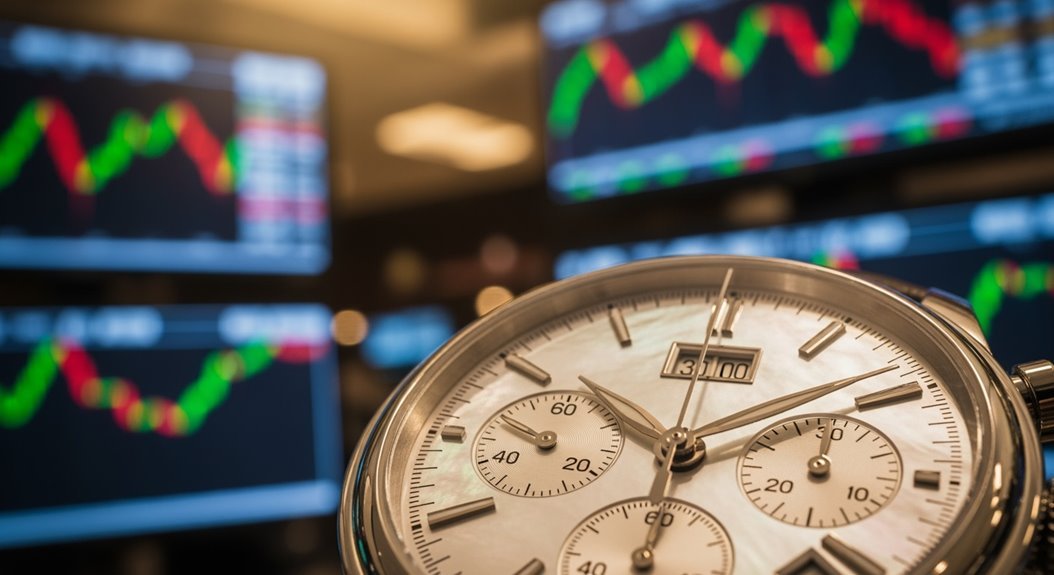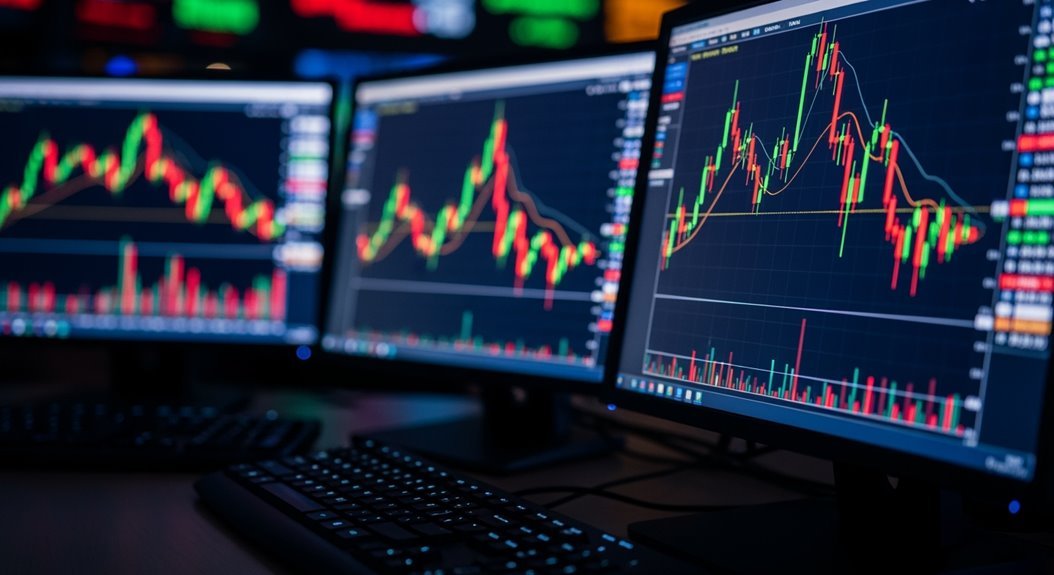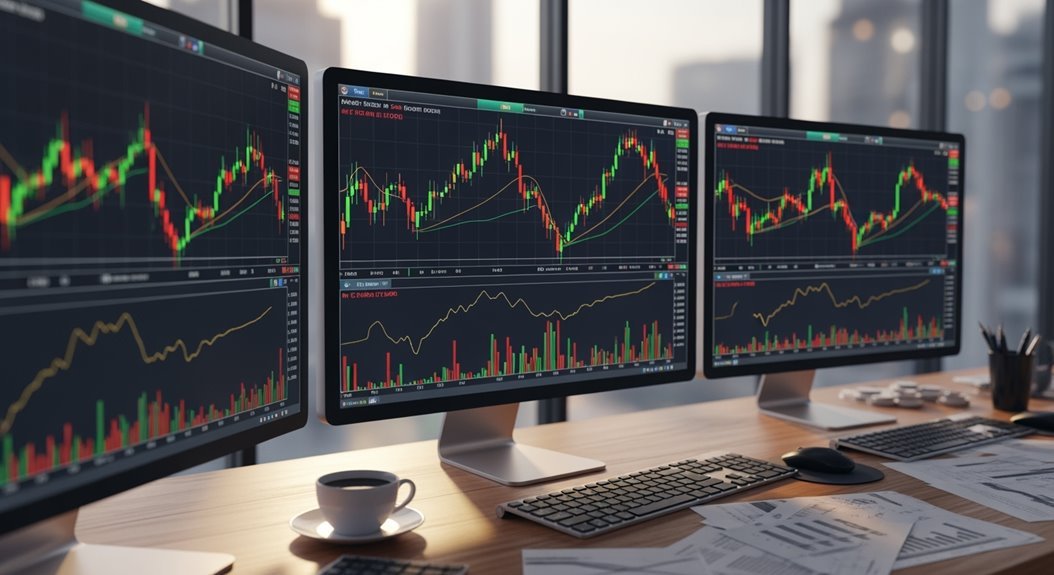Power hour in stock trading refers to the final 60 minutes before market close, from 3:00 PM to 4:00 PM EST. Trading volume spikes 30-40% above midday levels as institutional investors rush to adjust portfolios and meet performance targets. Retail traders and algorithms respond to increased volatility and price movements. Economic data releases and earnings reports during this window can dramatically shift market sentiment. The concentrated activity creates both opportunities and heightened risks that savvy traders learn to navigate.
Power Hour Timing and Market Dynamics

Typically, the final hour of trading transforms into a battlefield of heightened activity and strategic positioning. This period, known as Power Hour, runs from 3:00 PM to 4:00 PM Eastern Standard Time. Trading volume jumps 30-40% above midday levels. Volatility spikes.
A morning counterpart exists too. The first hour after markets open at 9:30 AM creates similar dynamics. Both windows align with NYSE and NASDAQ operating hours.
Why the surge? Institutional traders rush to close positions. Day traders scramble for last-minute profits. Others adjust portfolios before overnight risks kick in. The concentration of activity creates liquidity pools that benefit large orders.
The concentration of trading activity creates deep liquidity pools that institutional investors leverage for executing large block orders efficiently.
Price swings become more dramatic. News releases hit harder during these volatile windows. Power Hour reflects the convergence of institutional trading, end-of-day positioning, and market sentiment formation. However, it’s important to note that Power Hour can actually start as early as 2:00 PM rather than strictly at 3:00 PM. International markets show similar patterns, though timing shifts with regional trading hours. Forex and commodities follow suit. Resistance and support levels from earlier in the trading day often face their most significant tests during these final 60 minutes.
The result? A daily crescendo of market activity that savvy traders learn to navigate.
Key Factors Behind Elevated Trading Activity
Several forces converge to create Power Hour‘s trademark intensity. Economic data releases hit markets like clockwork. Employment reports, inflation numbers, GDP figures—all typically drop around this time. Markets react fast. Sharp price swings follow.
Institutional players drive the action. Hedge funds, mutual funds, pension funds execute massive trades. They’re adjusting portfolios, chasing performance targets, reacting to news. This creates a domino effect. Retail traders and algorithms pile on. The increased participant influx enables sharper price fluctuations and higher liquidity during these critical periods.
Central bank announcements pack serious punch. Fed decisions, FOMC minutes—they reshape risk appetite instantly. Interest rate expectations shift. Sectors rotate. Many traders set take-profit orders to automatically secure gains during volatile Power Hour movements. CPI reports frequently trigger significant market volatility as traders anticipate potential monetary policy adjustments.
Special market events amplify everything. Options expiration days bring position adjustments. Quadruple witching creates chaos as four contract types expire simultaneously. Volume explodes.
Corporate earnings add fuel. Major companies report quarterly results during Power Hour. Single announcements can move entire sectors. The combination of these forces—economic data, institutional activity, monetary policy, market events, and earnings—creates Power Hour’s volatile signature. Traders face accelerated losses when market volatility moves against their positions during these intense periods.
Trading Strategies and Risk Management Techniques
Power Hour demands split-second decisions and bulletproof risk management. Traders deploy various strategies during this volatile window. Momentum trading dominates. High volume enables quick entry and exit. Scalpers exploit fleeting price inefficiencies within minutes. Some swing traders initiate positions, capitalizing on heightened volatility.
Technical indicators become essential. VWAP and moving averages confirm entry points amid fast price action. Breakout traders target stocks breaking key resistance levels, amplified by elevated volume.
Risk management is everything. Tight stop-losses guard against swift reversals. Position sizes shrink to limit exposure. Limit orders control slippage better than market orders. Smart traders set maximum trade counts to prevent overtrading. Successful power hour traders maintain a structured schedule to avoid emotional decision-making and minimize impulsive trades.
Volume surges provide confirmation signals. Volatility measures help determine stop-loss targets. Day traders focus on seconds-to-minutes holding periods. Scalpers use ultra-short chart intervals. The high-pressure environment demands disciplined adherence to trading plans. Emotional responses must be managed. Experience separates survivors from casualties. Unlike futures contracts, power hour traders typically engage in spot trading where assets are exchanged at the current market price for immediate settlement.
Market Impact and Volatility Patterns

When the final hour approaches, trading volume explodes across U.S. markets. This surge creates dramatic volatility patterns that distinguish power hour from calmer mid-session periods.
Price swings accelerate. Rapid movements become commonplace as traders rush to close positions before the bell. The influx of participants—institutional investors, day traders, portfolio managers—creates a perfect storm of activity.
Volatility often triggers price gaps and breakouts. New information released near closing amplifies these moves. Technical indicators respond sharply to the rapid price changes, creating fresh trading opportunities for those quick enough to capitalize.
The chaos isn’t random. It’s driven by necessity. Day traders must finalize positions. Portfolio managers adjust holdings. Market makers scramble to balance books.
This concentrated volatility considerably influences major indices like the S&P 500 and Nasdaq. The final hour’s performance often sets the tone for after-hours trading and next-day sentiment. Algorithmic systems monitor these moves closely, adjusting exposure in real-time.
Frequently Asked Questions
Do All Stocks Experience Power Hour Effects Equally?
No, stocks don’t experience power hour effects equally. Large, liquid stocks show more pronounced activity due to institutional trading. Tech and growth stocks exhibit higher volatility from news and momentum. Small-cap stocks often display muted or erratic patterns. Blue-chip names reflect stronger volume spikes. Highly shorted stocks can produce outsized moves. Sector exposure, technical levels, and trading liquidity create uneven power hour impacts across different stocks.
How Does Power Hour Differ Between Small-Cap and Large-Cap Stocks?
Small-cap and large-cap stocks react differently during power hour. Large-caps show steadier, volume-driven moves thanks to institutional participation and higher liquidity. Small-caps experience sharper, more erratic swings due to thinner order books and retail trader activity. News hits small-caps harder during these periods. Large-caps use power hour for position adjustments. Small-caps see more aggressive momentum plays and breakout trades.
Can Power Hour Trading Be Profitable for Beginner Investors?
Power hour trading can yield profits for beginners, but success remains challenging. High volatility creates quick gain opportunities alongside swift loss potential. Beginners typically lack the speed and experience needed for effective risk management during rapid price movements. Success requires disciplined strategy, stop-loss orders, and extensive preparation. Starting with simulated trading or small positions proves advisable. Technical analysis skills and emotional discipline become essential for consistent profitability.
What Commission Costs Should Traders Expect During Power Hour Sessions?
Power hour commission costs largely depend on the brokerage. Most online brokers offer zero-commission trades on stocks and ETFs, even during volatile sessions. Traditional brokers may charge $4.95 to $9.99 per trade. High-frequency traders face additional fees for order routing priority. OTC stocks can trigger higher commissions due to increased risk. Volume-based discounts may apply. Hidden costs include margin interest and regulatory fees that accumulate quickly.
Are There Specific Sectors That Show Stronger Power Hour Activity?
Technology, financial, consumer discretionary, and energy sectors demonstrate the strongest power hour activity. Tech stocks surge on earnings releases and product announcements. Financial equities spike around economic news and derivative expirations, especially Fridays. Consumer discretionary moves on sentiment shifts and retail earnings. Energy stocks react to inventory reports and geopolitical events. Institutional participation intensifies across all sectors during final trading hour.



